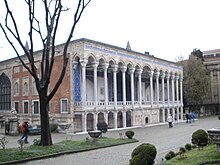Çinili Köşk
The Çinili Köşk (German tiled house or pavilion , English tiled kiosk ) is an Ottoman building on the grounds of the Archaeological Museum of Istanbul , which today serves as an exhibition building for Islamic-Turkish ceramics ( Çinili Köşk Müzesi ).
Building
The building is considered to be the oldest surviving part of the Topkapı Palace . It was laid out in 1472 by Sultan Mehmed II near his new palace as a pleasure pavilion ( kiosk ). Originally there were three pavilions of this type, which should symbolize the three world regions of the Ottoman Empire through their architectural styles (Greek, Turkish, Persian). This only building that has survived today represents the Persian architectural style.
The appearance of the building is determined by ceramic tiles in the Timurid style. The floor plan is cruciform with four Iwanen after the Persian model. Four domed corner rooms complete the floor plan to form a square. Only the dome of the central room protrudes over the flat roof.
The Sultan's throne stood in an apse that was added to the western Ivan and opposite the main entrance. According to the court poets, extravagant celebrations took place in this pavilion, which included feasts with the court pages and young women.
The wooden porch of the pavilion fell victim to a fire and was replaced in 1737 by the current portico.
From 1875 the Çinili Köşk served as a museum of antiquities before it was transferred to the neighboring new building. Since 1953 it has served as a ceramic museum.
museum
The museum's collection includes around 2,000 artifacts from the time of the Seljuk and Ottoman rulers (11th to 20th centuries). The most important tiles and pottery from the collection are exhibited in the pavilion, partly in showcases and partly set directly into the walls. The places of manufacture are İznik , Kütahya and Çanakkale .
One of the most important exhibits is a mihrab decorated with İznik ceramics from the Ibrahim Bey mosque in Karaman in Central Anatolia. Also significant are two arches from the medrese of the Haseki Hürrem mosque in Istanbul (16th century).
exhibition
Exhibit, mihrab with colored tiles from Karaman (1432)
Exhibit, arched field with colored tiles from the medrese of the Haseki Hürrem Sultan Mosque, Istanbul (approx. 1504)
Web links
literature
- Marcell Restle : Istanbul. Bursa, Edirne, Iznik. Monuments and museums ( Reclam's art guide ). Reclam, Stuttgart 1976, ISBN 3-15-010262-6 , pp. 339-341. 411.
- Stéphane Yerasimos: Constantinople. Istanbul's historical heritage . Potsdam 2009, ISBN 978-3-8331-5585-7 , p. 238 f.
- Baedeker Alliance Istanbul Travel Guide . 12th edition, Ostfildern 2011, p. 162 f.
Coordinates: 41 ° 0 ′ 43.3 " N , 28 ° 58 ′ 52.3" E





